Joseph Lyons
| The Right Honourable Joseph Lyons CH | |||||||||||||||||||||||||||||||||||||||||||
|---|---|---|---|---|---|---|---|---|---|---|---|---|---|---|---|---|---|---|---|---|---|---|---|---|---|---|---|---|---|---|---|---|---|---|---|---|---|---|---|---|---|---|---|
 | |||||||||||||||||||||||||||||||||||||||||||
| 10th Prime Minister of Australia | |||||||||||||||||||||||||||||||||||||||||||
|
In office 6 January 1932 – 7 April 1939 | |||||||||||||||||||||||||||||||||||||||||||
| Monarch |
George V Edward VIII George VI | ||||||||||||||||||||||||||||||||||||||||||
| Governor-General |
Sir Isaac Isaacs Lord Gowrie | ||||||||||||||||||||||||||||||||||||||||||
| Preceded by | James Scullin | ||||||||||||||||||||||||||||||||||||||||||
| Succeeded by | Earle Page | ||||||||||||||||||||||||||||||||||||||||||
| Leader of the Opposition | |||||||||||||||||||||||||||||||||||||||||||
|
In office 7 May 1931 – 6 January 1932 | |||||||||||||||||||||||||||||||||||||||||||
| Prime Minister | James Scullin | ||||||||||||||||||||||||||||||||||||||||||
| Deputy | John Latham | ||||||||||||||||||||||||||||||||||||||||||
| Preceded by | John Latham | ||||||||||||||||||||||||||||||||||||||||||
| Succeeded by | James Scullin | ||||||||||||||||||||||||||||||||||||||||||
| 26th Premier of Tasmania | |||||||||||||||||||||||||||||||||||||||||||
|
In office 25 October 1923 – 15 June 1928 | |||||||||||||||||||||||||||||||||||||||||||
| Governor | Sir James O'Grady | ||||||||||||||||||||||||||||||||||||||||||
| Preceded by | Sir Walter Lee | ||||||||||||||||||||||||||||||||||||||||||
| Succeeded by | Sir John McPhee | ||||||||||||||||||||||||||||||||||||||||||
| |||||||||||||||||||||||||||||||||||||||||||
| |||||||||||||||||||||||||||||||||||||||||||
| |||||||||||||||||||||||||||||||||||||||||||
| |||||||||||||||||||||||||||||||||||||||||||
| Personal details | |||||||||||||||||||||||||||||||||||||||||||
| Born |
Joseph Aloysius Lyons 15 September 1879 Stanley, Tasmania | ||||||||||||||||||||||||||||||||||||||||||
| Died |
7 April 1939 (aged 59) Sydney, New South Wales, Australia | ||||||||||||||||||||||||||||||||||||||||||
| Cause of death | Heart attack | ||||||||||||||||||||||||||||||||||||||||||
| Resting place | Mersey Vale Memorial Park, Quoiba | ||||||||||||||||||||||||||||||||||||||||||
| Political party |
Labor (to 1931) Independent (1931) UAP (after 1931) | ||||||||||||||||||||||||||||||||||||||||||
| Spouse(s) | |||||||||||||||||||||||||||||||||||||||||||
| Children | 12; including Kevin and Brendan | ||||||||||||||||||||||||||||||||||||||||||
| Education | Hobart Teachers' College | ||||||||||||||||||||||||||||||||||||||||||
| Occupation | Schoolteacher | ||||||||||||||||||||||||||||||||||||||||||
Joseph Aloysius Lyons CH (15 September 1879 – 7 April 1939) was the tenth Prime Minister of Australia, serving from January 1932 until his death. He had earlier served as Premier of Tasmania from 1923 to 1928, and was the first, and to date only, prime minister from Tasmania.
Lyons was born in Stanley, Tasmania, and was a schoolteacher and trade unionist before entering politics. He was elected to the Tasmanian House of Assembly in 1909, representing the Labor Party, and became a government minister in 1914, under John Earle. Lyons was elected party leader after the Labor government's defeat at the 1916 state election. He became premier in October 1923, after Walter Lee lost a no-confidence motion, and served until being defeated at the 1928 state election. He afterward entered federal politics.
Elected to the Division of Wilmot at the 1929 federal election, Lyons was immediately made a minister in the new government formed by James Scullin. However, he resigned from cabinet in January 1931 over a policy dispute, and two months later left the party altogether. He and several other Labor defectors subsequently helped to form the new United Australia Party (UAP), which elected Lyons as its leader. The UAP won government at the 1931 federal election, and was re-elected in 1934 and 1937. Lyons died of a heart attack in April 1939, becoming the first prime minister to die in office. His widow, Enid Lyons, later became the first woman elected to the House of Representatives.
Early life
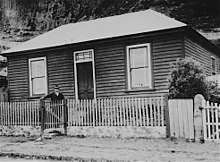
Birth and family background
Lyons was born in Stanley, Tasmania, on 15 September 1879. He was the fifth of eight children born to Ellen (née Carroll) and Michael Henry Lyons, both of Irish descent.[1] His mother was born in County Kildare and arrived in Australia in 1857, aged eleven,[2] while his father was born in Tasmania to immigrants from County Galway.[3] Lyons was the first prime minister to have an Australian-born parent.[1] His paternal grandfather, Michael Lyons Sr., had arrived in Tasmania in 1843 with his wife and an infant daughter. Initially an indentured labourer, he became a tenant farmer after completing his term of service,[3] and eventually saved enough to purchase land at Stanley, on the north-west coast. He had a reputation as a shrewd businessman, frequently buying and selling tracts of land and also dabbling in the hotel trade for a period.[4] His sons followed him into farming, and the Lyons family was prominent in the small local community.[5]
Childhood
When Lyons was four years old, his father moved the family from Stanley to Ulverstone, where he opened a combined bakery and butcher's shop.[6] In 1887, he lost the family's savings betting on the Melbourne Cup, driving them into poverty.[7] He had to sell the shop and resort to working as an unskilled labourer; his oldest children took part-time jobs to support the family. Lyons began working at the age of nine, as a printer's messenger boy. By the age of twelve, he was "cutting scrub" (clearing land) for local farmers.[8] Lyons had begun his education at the Ulverstone State School in 1885, before switching to the local Catholic school in 1887.[9] His early years of schooling were interrupted by his family's financial difficulties, and his attendance was sometimes irregular, though this was not uncommon in small rural schools at the time. In 1891, he moved back to Stanley to live with his aunts, Etty and Mary Carroll, and was enrolled at the Stanley State School.[8]
Teaching career
In 1895, aged fifteen, Lyons began working as a "pupil-teacher" under the monitorial system. This allowed him to continue his own education while being paid to teach younger students, and eventually qualify as a full-time teacher himself.[10] Outside of a three-month stint as a relief teacher at Irishtown, he remained at Stanley until early 1901, when he was given charge of two small "half-time" schools on the east coast – Apslawn and Apsley Meadows.[11] During that period, he lived at "Apsley House", the family estate of Sir William Lyne, Premier of New South Wales. In March 1902, Lyons transferred to the Midlands, taking charge of the schools at Conara and Llewellyn.[12] He was transferred again in July 1905 to Tullah, then a few months later to Smithton,[13] and then in April 1906 to Pioneer.[14] In 1907, Lyons moved to Hobart to attend the newly opened Hobart Teachers' College for a year.[15] He was then posted to Launceston, teaching at the Glen Dhu and Wellington Square State Schools, as well as briefly acting as headmaster at Perth.[16] He came into conflict with the Department of Education on a number of occasions, often complaining about poor working conditions. His superiors also disapproved of his political activities, which together with his complaints probably contributed to his frequent transfers and failure to win desirable postings.[17]
State politics
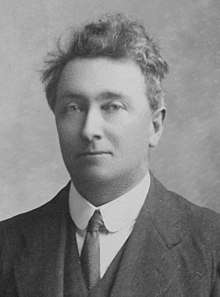
Lyons came from a family that was broadly sympathetic to the labour movement, but without any formal political involvement. Though widely read, he did not actively participate in politics until after leaving Stanley. Lyons helped found a branch of the Workers' Political League during his time in Smithton, but was forced to resign his membership due to restrictions on the involvement of public servants in political activities.[18] Those rules were later relaxed, and by 1908 he was spending most of his free time campaigning for the Labor Party;[19] he had a reputation as a first-rate orator.[17] Lyons was elected to the Tasmanian House of Assembly at the 1909 state election, standing in the six-member Division of Wilmot.[20] This required him to resign from the Education Department and give up his teaching career, which reduced his annual salary from ₤125 to ₤100.[lower-alpha 1][21] He was comfortably re-elected in 1912, although he was attacked with a horsewhip during one of his campaign speeches. The son of one of his political opponents was convicted of assault, and the incident received widespread media attention.[22]
Labor came to power in Tasmania in 1914, after the existing Liberal government of Albert Solomon was defeated on a confidence motion. The new premier was John Earle, who had previously held office for one week in October 1909.[23] In the new government, Lyons was made Treasurer, Minister for Education, and Minister for Railways; it was common for ministers to hold more than one portfolio.[24] He was somewhat inexperienced with economic matters, and often turned to his friend and colleague Lyndhurst Giblin for advice; they would eventually renew their relationship at federal level during the 1930s.[25] Less than a month after taking office, Lyons announced that the government was moving its accounts from the Commercial Bank of Tasmania to the Commonwealth Bank, which had only been established a few years earlier. In return he was able to secure a substantial loan and an overdraft of £100,000. The government would face a number of challenges during its two years in office, including a statewide drought, a series of bushfires in early 1915, and labour shortages due to the ongoing war.[26] As Labor was in minority, many of its legislative initiatives were thwarted by the opposition.[27] The party lost the 1916 state election by two seats, despite increasing its share of the vote.[28]
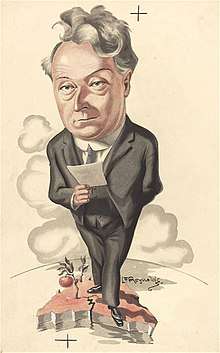
When the ALP split over conscription during the First World War in 1916, Earle, a pro-conscriptionist, followed Prime Minister Billy Hughes out of the Labor party. Like most Australians of Irish Catholic background, Lyons was an anti-conscriptionist and stayed in the Labor Party, becoming its new leader in Tasmania.[24]
He led the Labor opposition in the Tasmanian Parliament until 1923 when he became Premier, leading a minority ALP government. He held office until 1928, also serving as Treasurer during the whole period of his premiership. Lyons' government was cautious and pragmatic, establishing good relations with business and the conservative government in Canberra, but attracting some criticism from unionists within his own party. Labor narrowly lost the 1928 state election to the Nationalist Party.[29][24]
As premier, Lyons faced a constitutional crisis relating to the powers of the Tasmanian Legislative Council (the parliament's upper house). The Legislative Council had a limited franchise and was occupied mostly by conservative landowners, and was consequently opposed to much of the government's platform. Historically, it had claimed for itself the power to amend money bills, despite having no express constitutional authority to do so. In November 1924, the council returned the government's budget to the Legislative Assembly with a series of proposed reductions in spending. Lyons chose to ignore the amendments, instead sending the bill directly to the Administrator, Herbert Nicholls, who approved it. In 1926, the government amended the state constitution to codify the Legislative Council's powers over money bills, bringing them into line with the other states.[30]
On 15 July 1926, Lyons suffered severe leg injuries when his car—driven by a chauffeur—collided with a goods train near Perth. He came close to death, and stood down from public duties for four months to recover; Allan Guy was acting premier in his absence. Michael O'Keefe, the Speaker of the House of Assembly, was also a passenger in the car, and lingered for several months before dying of his injuries.[31]
Federal politics
At the 1929 election Lyons ran for the federal seat of Wilmot, covering the same territory as his state seat. He was swept into office in Labor's landslide victory under James Scullin. He was appointed Postmaster-General and Minister for Works and Railways.[32]
When the Depression struck in 1930, the Scullin government split over its response. Lyons became the leading advocate within the government of orthodox finance and deflationary economic policies, and an opponent of the inflationary, proto-Keynesian policies of Treasurer Ted Theodore. Theodore was forced to resign over accusations of corruption in June 1930, and Scullin took over the Treasury portfolio in addition to the Prime Ministership. Lyons served as acting Treasurer from August 1930 to January 1931, whilst Scullin was in Britain for the Imperial Conference. Lyons announced his plan for recovery in October 1930, insisting on the need to maintain a balanced budget and cut public spending and salaries, although also advising lower interest rates and the provision of greater credit for industry.[24]
His conservative economic approach won him support among business, but angered many in the Labor caucus, who wanted to expand the deficit to stimulate the economy, and were horrified at the prospect of cuts in salaries and government spending. Alienated by their attacks, Lyons began to consider suggestions from a group of his new business supporters, including influential members of the Melbourne Establishment, that he leave the government to take over the leadership of the conservative opposition.[24][32]
Resignation from the Labor Party
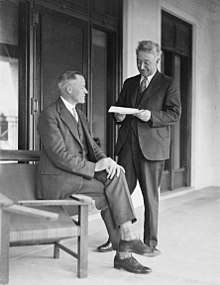
When Scullin returned in January 1931, he reappointed Theodore (as it had become clear Theodore would not be charged with corruption) to the Cabinet as Treasurer, which Lyons took as a rejection of his own policies. Lyons immediately resigned from the Cabinet, and then in mid–March from the Labor Party.[33] Accompanied by another senior minister in the Scullin government, James Fenton, and four other right-wing Labor MPs, he formed the "All for Australia League" and crossed the floor to sit on the opposition benches. Soon afterward, Lyons and his supporters joined with the opposition Nationalist Party and the Australian Party, a small party led by Billy Hughes, to form a new party, the United Australia Party (UAP).[24][32]
Although the UAP was essentially an enlarged Nationalist Party, Lyons was chosen as leader of the party. He thus became Leader of the Opposition, with former Nationalist leader John Latham as his deputy. The UAP realised that Lyons, an affable family man with the common touch, was a far more electorally appealing figure than the aloof Latham. Additionally, his Labor background and his Catholicism would allow him to win traditional Labor constituencies (working-class voters and Irish Catholics) over to what was essentially an upper- and middle-class conservative party.
In March, at about the same time as Lyons led his group of defectors from the right of the Labor Party across the floor, five left-wing NSW Labor MPs, supporters of New South Wales Premier Jack Lang, also split from the official Labor Party over the government's economic policies (for Lyons they had been too radical, for the Langites they were not radical enough), forming a "Lang Labor" group on the cross-benches and costing the government its majority in the House of Representatives. Late in the year, the Langite MPs supported a UAP no-confidence motion and brought the government down, forcing an early election.[32]
Prime Minister
.png)
At the 1931 election Lyons and the UAP offered stable, orthodox financial policies in response to what they branded as Scullin's poor stewardship of the economy. While Labor remained split between the official party and the Langites, the UAP projected an image of putting national unity above class conflict. The result was a huge victory for the UAP, which took 34 seats against 18 seats for the two wings of the Labor Party combined.
At the outset, the UAP did not renew the traditional non-Labor Coalition with the Country Party. then led by Sir Earle Page. While the two parties ran separate House campaigns, they presented a joint ticket for the Senate. The massive swing to the UAP left it only four seats short of a majority in its own right. The five MPs elected for the Emergency Committee of South Australia, which stood for the UAP and Country Party in South Australia, joined the UAP party room, giving the UAP a bare majority of two seats. While Lyons was still willing to take the Country Party into his government (which would have commanded over 70 percent of the seats), negotiations stalled, and Lyons decided to govern alone.[34] The new government was sworn in January 1932. Lyons became the third former federal or state Labor leader (after Hughes and Joseph Cook) to become a non-Labor Prime Minister.
After the UAP suffered an eight-seat swing in the 1934 election, Lyons was forced to invite the Country Party into his government in a full Coalition. Until 1935 Lyons served as treasurer as well as prime minister. In office, Lyons followed the same conservative financial policy he had advocated during the Scullin government, cutting public spending and debt.[35] He benefited politically from the gradual worldwide recovery that took place after 1932.
As far as foreign policy was concerned, Lyons was a firm though by no means servile ally of Britain, and also supported the League of Nations. His government tended to support the conciliation of the dictatorships of Germany, Italy, and Japan to avoid another world war, but he still increased military spending. As a result, he ensured an expansion of the armed forces, the opening of an aircraft factory, and the planning of new munitions factories and shipyards.
In April 1933, Western Australia voted overwhelmingly to secede from the rest of the country. Lyons spent two weeks campaigning for the "No" vote with George Pearce and Tom Brennan. The state's isolation at the time was such that he had to appoint John Latham as acting prime minister for the duration of the trip. Despite the result of vote, the federal government viewed secession as unconstitutional and refused to allow Western Australia to leave the federation. The state's appeal to the British government to intervene was also unsuccessful.[36] In July 1933, Lyons established the Commonwealth Grants Commission to provide impartial advice about the distribution of federal government grants to the states; in remains in existence.[37]
|
|
Lyons was prime minister during the Edward VIII abdication crisis of 1936. He and the other Dominion leaders were only officially informed of the king's intention to abdicate a few weeks before it occurred, although he had found out about the situation earlier through unofficial channels. Lyons strongly opposed the proposed marriage to Wallis Simpson, a view shared by his cabinet; it is unclear if he was initially aware how deep the king's feelings were. He later telegraphed the king asking him not to abdicate, and after the event gave a speech in parliament announcing his regret at the king's decision.[38] Lyons is the only Australian prime minister to have held office during the reigns of three monarchs, and the only prime minister to serve throughout a monarch's entire reign.
At the 1934 election the ambitious and talented Robert Menzies entered Parliament, and was immediately seen as Lyons' successor, although he denied that he was seeking to displace Lyons.
The government won a third term at the 1937 election, with 44 of 74 seats and 50.6 percent of the two-party preferred vote against a reunited Labor Party led by John Curtin. As the international situation darkened in the late 1930s, Lyons, a long-term pacifist, became increasingly despondent. Most politicians expected that he would soon be replaced by Menzies, who resigned from Cabinet in protest at the government's inaction on the national insurance scheme.
Death

On 5 April 1939, Lyons suffered a heart attack while being driven from Melbourne to Sydney. It occurred shortly after he had stopped in at Goulburn to collect his son Kevin from St Patrick's College for the Easter holidays. Lyons was rushed to St Vincent's Hospital, Darlinghurst, in a critical condition.[39] By the following day, he was unable to speak and was drifting in and out of consciousness. He soon fell into a coma, and died on the morning of 7 April, which was Good Friday.[40] Lyons' body lay in state at St Mary's Cathedral until 10 April (Easter Monday). A requiem service was held the following day, and then a procession bearing his coffin proceeded from the cathedral to Circular Quay. Lyons' body was transported to his home town of Devonport aboard HMAS Vendetta. His funeral was held at the Church of Our Lady of Lourdes on 13 April, and he was buried in the church grounds. He was re-interred in the new Mersey Vale Memorial Park in 1969, where he was joined by his wife in 1981.[41]
Lyons was the first Australian prime minister to die in office; only Harold Holt died at a younger age. There was no constitutional precedent as to who should be appointed as his successor, and the situation was further complicated by the UAP's lack of a deputy leader. When the seriousness of Lyons' condition became apparent, Earle Page—the leader of the Country Party and de facto deputy prime minister—called a cabinet meeting, where it was agreed that he should serve as prime minister on an interim basis while the UAP elected a new leader. He was sworn in by Governor-General Lord Gowrie a few hours after Lyons' death. The UAP leadership ballot was held on 18 April and won by Robert Menzies, who replaced Page as prime minister on 26 April. According to Laurie Fitzhardinge, Lyons' death "removed the only force that had held in check the smouldering animosities and barely suppressed rivalries which divided [the UAP's] members".[42]
Personal life
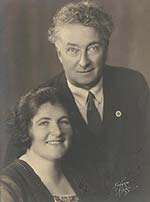
On 28 April 1915, Lyons married Enid Burnell, the daughter of a family friend; she was almost 18 years his junior.[43] He had begun courting her in 1912, when she was 15.[44] The couple would have twelve children together:
- Gerald Desmond (1916–2000)
- Sheila Mary Norma (1918–2000)
- Enid Veronica (1919–1988) – married army officer Maurice Austin
- Kathleen Patricia (1920–2012)
- Moira Rose (1922–1991)
- Kevin Orchard (1923–2000)
- Garnet Philip Burnell (1924–1925)
- Brendan Aloysius (1927–2010)
- Barry Joseph (1928–2015)
- Rosemary Josephine (1929–1999)
- Peter Julian (b. 1931)
- Janice Mary (b. 1933)
Before his marriage, Lyons had briefly been engaged to Pearl "Pib" Bailey, whom he met while teaching at Conara in about 1902. He broke off their relationship for uncertain reasons, but they remained firm friends; Bailey never married and kept the love letters they exchanged for the rest of her life.[45]
Joseph and Enid Lyons' great-grandson is married to the great-granddaughter of Billy Hughes.[46]
Legacy

Lyons was one of the most genuinely popular men to hold the office of prime minister, and his death caused widespread grief.[35] His genial, laid-back appearance often led to his portrayal in cartoons as a sleepy koala.[24] A devout Catholic, he was the second Catholic to become prime minister, after his immediate predecessor Scullin, and the only non-Labor Catholic prime minister until Tony Abbott.
Gregory Melleuish has compared Lyons to Adolf Hitler, Franklin D. Roosevelt, and Joseph Stalin, in that all were charismatic leaders whose popularity and political longevity could be attributed to the unique circumstances of the Great Depression era. Melleuish observes that: "of all those leaders the one who is least remembered in his own country, and yet did both the greatest good and the least harm to his fellow citizens, was Joe Lyons".[47]
Lyons is the only person in Australian history to have been prime minister, Premier of a State, and Leader of the Opposition in both the Federal Parliament and a State Parliament (although George Reid had served as premier of a colony before Federation). Lyons is also the only prime minister to have come from Tasmania. At the time of his death, he was the second-longest serving prime minister in Australia's history, behind only Hughes.
Dame Enid Lyons later went into politics in her own right, in 1943 becoming the first woman to sit in the House of Representatives, and later the first woman Cabinet Minister in Menzies' Liberal government. Two of their sons later became involved in Tasmanian state politics in the Liberal Party: Kevin Lyons was Deputy Premier between 1969 and 1972, and Brendan Lyons served in the ministry of Robin Gray during the 1980s.
Honours
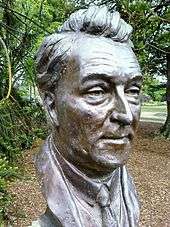
In 1984, Lyons' old seat of Wilmot was renamed the Division of Lyons jointly in honour of Lyons and his widow Dame Enid Lyons. The state seat of Wilmot was also renamed Lyons for the same reason.
The Canberra suburb of Lyons, Australian Capital Territory is named in honour of Joseph Lyons.
In 1975, he was honoured on a postage stamp bearing his portrait issued by Australia Post.[48]
See also
Notes
- ↑ Tasmanian MPs did not get a pay rise until 1913, when their salary doubled to ₤200. Lyons was among those who argued for the amount to be increased, on the grounds that their remuneration was insufficient to cover the larger electorates introduced in 1909.
References
- 1 2 Henderson, Anne (2011). Joseph Lyons: The People's Prime Minister. UNSW Press. p. 11. ISBN 1742240992.
- ↑ Henderson (2011), p. 13.
- 1 2 Henderson (2011), p. 14.
- ↑ Henderson (2011), p. 15.
- ↑ Henderson (2011), p. 16.
- ↑ Henderson (2011), p. 18.
- ↑ Henderson (2011), p. 21.
- 1 2 Henderson (2011), p. 22.
- ↑ Henderson (2011), p. 19.
- ↑ Henderson (2011), p. 25.
- ↑ Henderson (2011), p. 30.
- ↑ Henderson (2011), p. 43.
- ↑ Henderson (2011), p. 44.
- ↑ Henderson (2011), p. 46.
- ↑ Henderson (2011), p. 47.
- ↑ Henderson (2011), p. 50.
- 1 2 Henderson (2011), p. 51.
- ↑ Henderson (2011), p. 45.
- ↑ Henderson (2011), p. 54.
- ↑ Henderson (2011), p. 64.
- ↑ Henderson (2011), p. 59.
- ↑ Henderson (2011), pp. 75–76.
- ↑ Lake, Marilyn (1981). "Earle, John (1865–1932)". Australian Dictionary of Biography. 8. Canberra: Australian National University.
- 1 2 3 4 5 6 7 Hart, P. R.; Lloyd, C. J. (1986). "Lyons, Joseph Aloysius (1879–1939)". Australian Dictionary of Biography. Canberra: Australian National University. Retrieved 13 January 2008.
- ↑ Henderson (2011), p. 101.
- ↑ Henderson (2011), p. 99.
- ↑ Henderson (2011), p. 103.
- ↑ Henderson (2011), p. 104.
- ↑ Serle, Percival. "Lyons, Joseph Aloysius (1879–1939)". Dictionary of Australian Biography. Project Gutenberg Australia. Retrieved 13 January 2008.
- ↑ Henderson (2011), pp. 159–163.
- ↑ Henderson (2011), p. 177.
- 1 2 3 4 "Joseph Lyons, before". Australia's Prime Ministers. National Archives of Australia. Retrieved 13 January 2008.
- ↑ The Companion to Tasmanian History: Joseph Lyons. University of Tasmania. Retrieved 20 June 2018
- ↑ Page, Sir Earle Christmas (1880–1961), Australian Dictionary of Biography
- 1 2 "Joseph Lyons, in office". Australia's Prime Ministers. National Archives of Australia. Retrieved 13 January 2008.
- ↑ Henderson (2011), p. 343–344.
- ↑ Henderson (2011), p. 329.
- ↑ Henderson (2011), pp. 383–388.
- ↑ Henderson (2011), p. 428.
- ↑ Henderson (2011), p. 429.
- ↑ Henderson (2011), p. 430.
- ↑ Fitzhardinge, Laurie (1979). William Morris Hughes: A Political Biography / Vol. II: The Little Digger, 1914–1952. Angus & Robertson Publishers. pp. 650–651.
- ↑ Henderson (2011), p. 95.
- ↑ Henderson (2011), p. 85.
- ↑ Henderson (2011), pp. 35–41.
- ↑ Andrew Brown, Prime ministers' descendants descent on Canberra, Sydney Morning Herald, 9 June 2018. Retrieved 9 October 2018
- ↑ Gregory Melleuish (1 January 2012). "The National Character in Joe Lyons". Quadrant. Retrieved 24 July 2018.
- ↑ Australian stamp
Further reading
- Henderson, Anne (2000), 'Joseph Aloysius Lyons,' in Michelle Grattan (ed.), Australian Prime Ministers, New Holland, Sydney, New South Wales, pages 152–167. ISBN 1-86436-756-3
- Hughes, Colin A (1976), Mr Prime Minister. Australian Prime Ministers 1901–1972, Oxford University Press, Melbourne, Victoria, Ch.11. ISBN 0-19-550471-2
External links
- Tasmanian Parliamentary library profile
- Newspaper clippings about Joseph Lyons in the 20th Century Press Archives of the German National Library of Economics (ZBW)
| Wikimedia Commons has media related to Joseph Lyons. |
